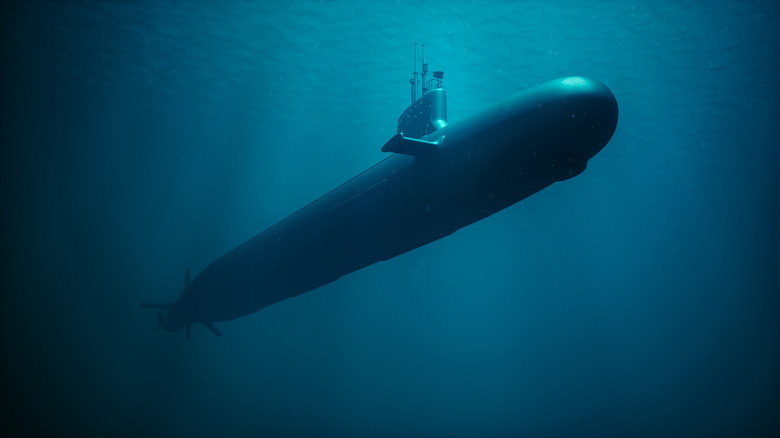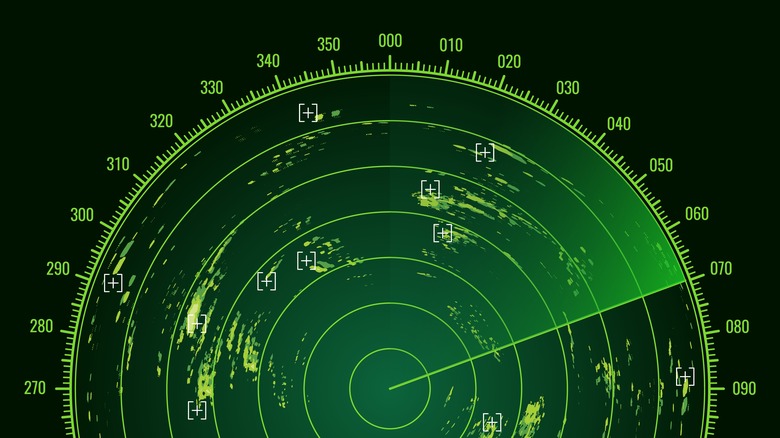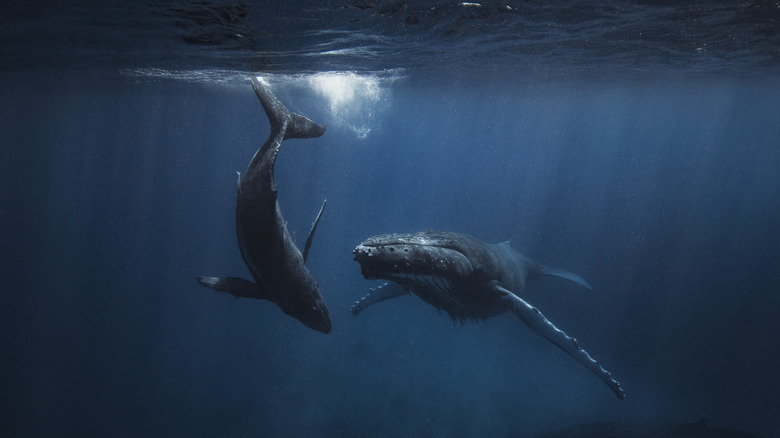The Hidden Impact Of Military Sonar On Marine Life
In 1906, Lewis Nixon invented the first sonar-type listening device to detect icebergs. Years later, Sound Navigation and Ranging (SONAR) became a staple in naval military warfare for its ability to detect submarines. With the ocean bed holding critical oil and communication lines, submarines are key to surveillance practices necessary for threat assessment and protection. However, there are a lot of unique challenges with submarines, including navigation.
With so much of the ocean bed still unmapped, sonar technology is used to detect geological structures underwater. Sonar is critical for people to find their way around the ocean, search for objects, and make sure threats are detected before they cause any harm. However, humans aren't the only ones to use sound waves to make sense of their surroundings. Many animals rely on echolocation or biological sonar to live, especially in the ocean. Here's why the military's use of sonar is terrible for our friends underwater.
Passive vs active sonar: why it matters
According to the National Oceanic and Atmospheric Administration (NOAA), there are two types of sonar: active and passive. When it comes to passive sonar, its systems can detect noise from typically loud sounds in the water. However, it can't measure how far an object is without additional listening devices that can be used to triangulate a sound's position. While it's useful for finding submarines, it's not as effective when it comes to predicting distance.
Alternatively, active sonar works similarly to a bat inside a dark cave. Active sonar uses energy pulses to determine an object's distance based on how long it takes before the sound bounces back. Although this opens up a risk of being located by other submarines, the U.S. Fleet Forces Command claims that it's still the most effective way that a fleet can locate objects underwater.
Unfortunately, this doesn't bode well for marine animals, who also rely on sound to find their way. Aside from this, marine animals are also at the mercy of other artificial noise pollution in the water. In 2019, The New York Times claimed that the increasing ship traffic, use of sonar, and routine seismic air gun blasts put marine animals at risk. Here's a look at how and why this happens.
The impact of sonar on marine animals
Citing an unpublished report from the UK military, a Nature study revealed that marine animals were confirmed to stop vocalizing and foraging for food during marine exercises in 2008. Since then, evidence has been mounting on the unintended consequences of this military innovation.
Not all active sonar signals are the same. The output power will vary depending on the system's objective, such as detecting objects in shallow water or for military use. According to the Australian government's Department of Climate Change, Energy, the Environment and Water, military radar is categorized as low-frequency signals below 1,000 Hz, medium-frequency at 1,000 to 10,000 Hz, and high-frequency at 30,000 to 500,000 Hz.
For higher-frequency active sonar, the sounds emitted are short, fast, and often called "pings." While these pings don't last long, they can still be dangerous due to their intensity. In 2009, Scientific American said that the sound waves from these pings can travel hundreds of miles and retain an intensity of 140dB as far as 300 miles from their source.
The National Resource Defense Council (NRDC) claims that sonar causes acoustic or impulse trauma, which leads to devastating physiological impacts. Some whales have been caught rapidly changing depth to avoid sonar, leading to internal bleeding and ruptured lung tissues. Aside from this, some startled animals have also been noted to flee from natural foraging or breeding grounds. Whales have been known to beach themselves just to escape the sound.
Ethical considerations of sonar technology
In 2015, the U.S. District Court ruled that the Navy War Games on the coasts of Southern California and Hawaii violated laws protecting whales and dolphins. Citing feeding, communication, and mating disruptions, the military's five-year plan would have included high-intensity sonar exercises and underwater detonations. The U.S. Navy began limiting sonar testing after its spat with the National Marine Fisheries Service (NMFS), the institution tasked with protecting marine animals in the country.
Three years later, the U.S. Department of Defense released a document on Atlantic Fleet Training and Testing detailing the Navy's existing mitigation measures to avoid harming marine animals. Among these measures, the U.S. Navy cites posting lookouts and establishing mitigation areas for seafloor resources, such as shallow coral reefs, artificial reefs, and live hard bottoms. In addition, it also discusses rules, like halting activities when a marine mammal or sea turtle is observed and avoiding important areas during specific times of the year.
Unfortunately, until a better type of navigation technology is invented, sonar will continue to be a part of every naval military's arsenal. However, with legislation and better knowledge of the seafloor in place, military units can better avoid the areas wherein sonar technology can create the most damage. With time, we can hope that technological advancements will make it possible for a better (and quieter) way to navigate in the water.



